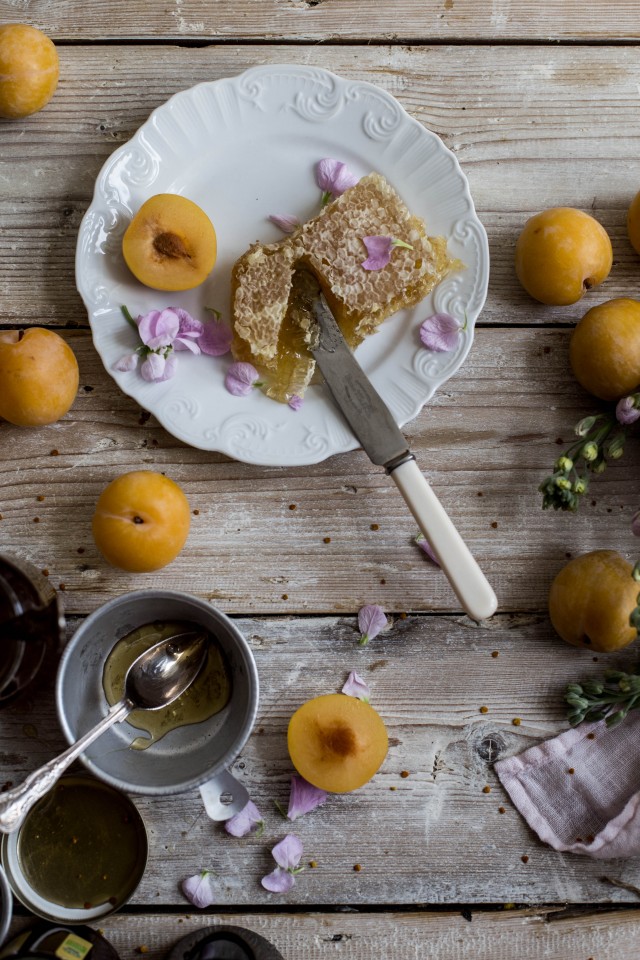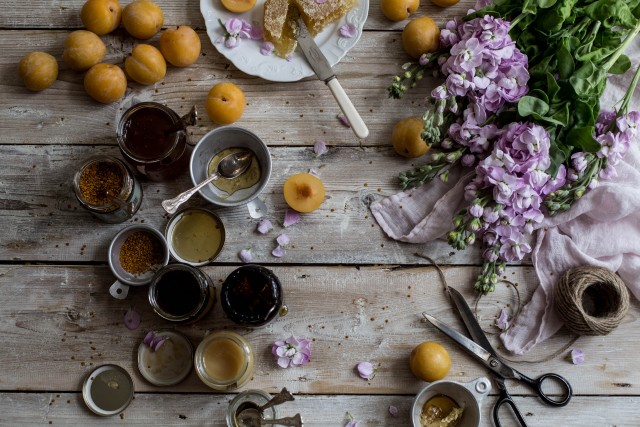Text By Lily Panyacosit Shields
Photograph By Skye McAlpine
“I don’t feel very much like Pooh today,” said Pooh.
“There there,” said Piglet. “I’ll bring you tea and honey until you do.”
― A.A. Milne, Winnie-the-Pooh
Honey, in it’s raw, unprocessed, unfiltered, unpasteurized and straight-from-the-hive form, is a beautifully complex food. It is naturally composed of approximately 200 substances. And of these 200 substances, up to 80 of them are important for human nutrition and healing. Besides glucose and fructose, honey contains: all of the B-complex, A, C, D, E, and K vitamins, minerals and trace elements such as magnesium, iron, and calcium etc. Honey also has the highest levels of live enzyme content of all foods and contains pollen and antimicrobial factors.
Of course Pooh and Piglet didn’t know any of this, they just knew that it would make Pooh feel better. And it probably made him feel better on a number of different levels because honey actually boasts a myriad of healing benefits. Honey has been used to treat a wide variety of ailments for thousands of years, with almost every ancient civilization from the Greeks, to the Egyptians, to the Chinese, having documented the use of honey for the healing of various conditions. Apitherapy is the use of bee products (including honey, bee pollen, royal jelly, propolis and bee venom) as medicine, and was founded sometime in 4,000 B.C. In fact, bees and honey were considered so sacred, that bees were worshipped by many and honey could only be given away, never sold.
The advent of penicillin and antibiotics greatly diminished the important role of honey in medicine. As the importance of honey and bees has lessened in our lives, so has our regard for their intrinsic beauty and value. Generally speaking, honey and bee colonies, previously honored and sacred, are today regarded as mere commodities, services and products to be sold on the open market for a profit. Bee colonies and the honey they produce are being ‘managed’ or ‘controlled’ accordingly. When commercial beekeepers harvest honey to sell, for example, hives are depleted of honey, disregarding the fact that honey is used by bees for food all year round, especially during the winter months when there are no flowers to pollinate.
Unfortunately, these industrial beekeeping practices have tainted the honey we buy. Impurities have found their way into our honey from the contaminated nectar of plants and flowers the bees visit as well as by the manner in which bees are cared for. They include, but are not necessarily limited to:
– sugars and other carbohydrates, e.g. high fructose corn syrup (HFCS), glucose, molasses, flour and starch. Sugars are sometimes added to ‘stretch’ the honey whereas HFCS is used to prep and reinvigorate bees transplanted for the pollination of monoculture crops. All are used to substitute the bees natural diet following the depletion of honey from the hives.
– bee and hive medications, such as antibiotics, fungicides and mite killing chemicals.
– chemicals from plastics, which originate from the process of heating the honey in plastic containers.
– pesticides, which are liberally sprayed on gardens and crops around the globe.
All these impurities have damaged the health of the bees as it has ours in the process. Sadly, Rudolf Steiner predicted, way back in 1923, that if humanity continued to cultivate bees by artificial means, interfering with the bees natural processes, we would within eighty years observe the mass disappearance of bees … and we have.
Thankfully, we are rediscovering the miraculous creatures that bees are and the inexplicably numerous and positive ways in which honey affects us. In the same way I mentioned that honey is a beautifully complex food, humans are beautifully complex organisms. It can only follow that when consumed, honey would have beautifully complex and multifaceted effects on us humans. Let’s take a look at the components of honey and how they affect us:
– Antioxidants: Honey contains bioflavonoids (plant based molecules that have antioxidant properties) (with levels as high as in strawberries and spinach.) These antioxidant properties aid the body in fighting cancer, heart disease, degenerative diseases such as Alzheimer’s, and in fighting free radicals at wound sites.
– Antimicrobial: Raw honey is a wonderful antibiotic and a must-have for any first aid kit. When in contact with a wound, honey produces hydrogen peroxide, a natural antiseptic. Honey also creates a hostile environment for harmful bacteria by making it too acidic and too dry for them to survive. Honey can be used to dress burns, ulcers, bed sores and other skin infections, and is incredibly effective at keeping both infection at bay and reducing scarring. Medical grade honeys such as Manuka honey, Jellybush honey and pasture honeys effectively treat antibiotic resistant strains of bacteria in the body. Even more significantly, none of these honeys promote the growth or spread of antibiotic-resistant superbugs.
– Fructose:Glucose ratio: Honey contains an almost equal ratio of fructose to glucose. Due to this trait, if we (a) decreased the amount of sugar we ate, and (b) substituted honey for the sugar we do eat, we would more readily avoid developing cardiovascular diseases, Type 2 diabetes, obesity, high cholesterol etc.
– Glucose: The glucose in honey stimulates our brain to release melatonin, a hormone which helps us to sleep better and stabilizes blood sugar levels. Melatonin is also known to boost immunity and facilitate the rebuilding of our tissues during rest.
– Oligosaccharides: are probiotics that help “good” prebiotic gut bacteria, such as lactobacilli and bifidobacteria, to grow and activate. This is especially important, since we are learning that a lack of “good” digestive bacteria (flora) in our gut may in fact be partly responsible for causing diabetes and obesity.
– Pollen: Bees carry the pollen that causes seasonal allergies and some of that pollen becomes a part of the honey. Consuming high quality, raw local honey before allergy season can lessen your sensitivity to pollen and reduce allergy symptoms. Note that consuming raw honey is essential, as pollen is completely removed and absent from commercial honey.
Honey is not a quick fix, but honey, as one ingredient in an antioxidant-rich diet with vegetables and fruits coupled with a healthy lifestyle, will boost your immune system and may help keep many diseases at bay. This is especially true when you note that some of the effects of honey overlap and act synergistically. Thus, a teaspoon a day, or 3, of honey, might just be more effective than an apple a day in keeping the doctor away.
“Honey comes out of the air…At early dawn the leaves of trees are found bedewed with honey… Whether this is the perspiration of the sky or a sort of saliva of the stars, or the moisture of the air purging itself, nevertheless it brings with it the greatest pleasure of its heavenly nature. It is always of the best quality when it is stored in the best flowers.”
Pliny (A.D. 23-79) ‘Natural History”, book 20
In other words, the quality of the honey depends greatly on the source of its nectar and pollen. Honeys of different origins can vary in strength and disease-fighting characteristics, with the general rule of thumb being, the darker the honey, the better. It should follow then that the environment in which the bees are raised, and perhaps even more importantly, the manner in which the bees are cared for, will also deeply affect the quality and the characteristics of the honey.
Honey is a gift bees impart to us. Ethical biodynamic beekeepers, or rather “bee-havers” devote their lives to preserving these amazing insects and as a result, this natural healing wonder known as honey. I would encourage you to get to know your local bee-haver and ask for organic, raw, unprocessed and unfiltered honey straight from loved and respected hives. In doing so, you will obtain honey of the highest quality while helping to safeguard the welfare of the bees, so that they may continue to bequeath this gift on future generations.
Follow Lily on instragram
Follow Skye on instagram


Dear Lily & Kirsten,
Thank you for a very well-rounded and informative article.
Just one note: oligosaccharides are pre – not probiotics. Honey is a prebiotic that feeds the good bacteria in our digestive system. Also, it would be useful to see a list of resources for the data provided, so one can complement the information with further research. 😉
Again, thank you!
Debra
Thank you so much for pointing that out. Lily actually wrote prebiotics and I know I changed it by mistake to probiotics with spell check. I have corrected it 🙂 thank you! There is a full footnoted version of this article available also, it was my feeling that it was too scholarly for our journal so I had Lily revise it and take the footnotes out (which I will add she did a fantastic job at) and I am sure she would be very happy to share the footnoted version with you, please feel free to write to Lily, ps4lily@gmail.com Thank you so much for reading and for your great feedback. Kirsten
One of my readers so rightly pointed out that honey is also the product with the most flight miles per kilogram of any other and also produced entirely by women.
Ahhh that is is such a great thing to think off! Yay Girls! xoxo